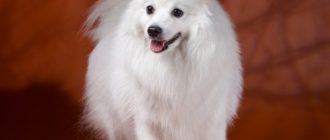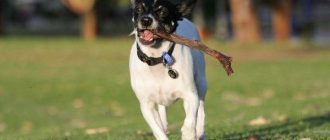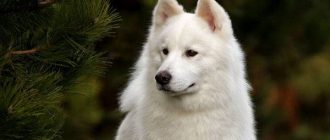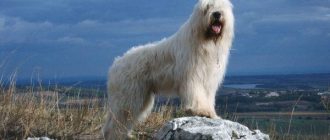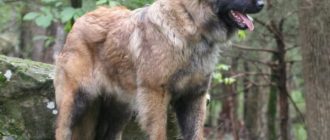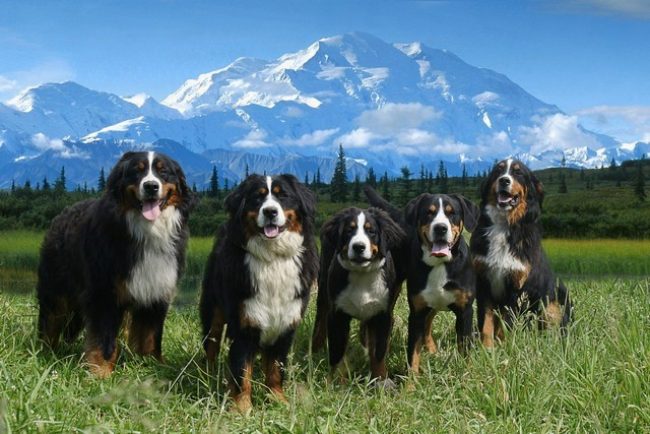
Classification
Origin: Switzerland
Class: Group 2 according to FCI. Pinschers and schnauzers, Molossoid and swiss shepherd dogs. Section 3. Swiss shepherd dogs. Without working trials. Section 3. Swiss cattle dogs.
Color: glossy – black primary color, bright red – brown tan marks on the cheeks, eyebrows, paws and chest. Snow-white symmetrical markings on the head: expanding to the nose the strip on both sides of the muzzle should not touch the red marks above eyes and go wider than the corners of the mouth. Moderately wide white markings on the throat and chest without tears. White paws and white are desirable the tip of the tail. Small white spots under the tail and on scruff of the neck.
Sizes: Height at the withers of dogs 64 – 70 cm, female 58 – 66 cm. Ideally, males 66 – 68 cm, females 60 – 63 cm.
Life expectancy: average 10 – 13 years old.
Bernese Mountain Dog is a universal companion. Flexible character and luxurious appearance make this breed unique.
Bernese Mountain Dog is a great family dog that is capable of “find a common language” with all households. Many breeders sincerely believe that their pets know how to smile.
The friendliness of the breed allows them to find Understanding with any other pets.
They are very kind to children, becoming real for them friends. Given this, the breed is very popular and lovers the puppy’s rather big price doesn’t scare.
More about the other best breeds dogs: https: //kot-pes.com/samyie-dobryie-porodyi-sobak/
Content
- 1 Breed History
- 2 Psychology
- 3 Application
- 4 How to choose a dog
- 5 Care features
- 6 combing
- 7 Walk
- 8 Power
- 9 Health
- 10 Vaccinations
- 11 Knit
Breed history
Contents
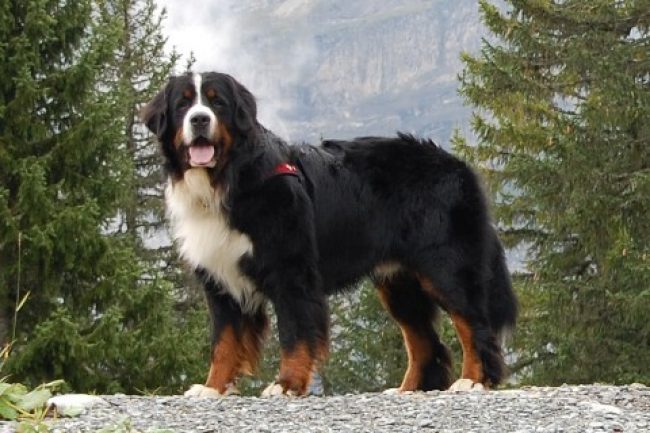
Many years of natural selection and the work of breeders have led to creating one of the most beautiful dogs on the planet.
Regarding the origin of the breed, there are two main version.
According to the first of them, the breed has been known since the time of Ancient Roman Empire, mention of this peasant dog refers to the first century BC. e., and belongs to the ancient Roman to author Columellas.
Description of the breed is almost completely consistent with modern breed standards. At that time, the Bernese Mountain Dogs grazed cattle, helped hunt and protected their masters and their homes.
Other historical sources say that the ancestors of the breed were brought by the Romans after the victory of Caesar and the announcement of Switzerland (at that time Helvetia) a Roman province.
Today, according to the official version of origin breed recorded in cynological literature is considered line: Great Dane – Roman Molossian – Central European dog-shaped dog – mountain dog.
In the Middle Ages, inheriting the Roman legionnaires, residents of Switzerland used the mountain dogs in the battles.
In the mid-15th century, this breed was at risk of complete destruction.
This was directly connected with the decree of the Zurich burgomaster about complete extermination of all large peasant dogs destroying vineyards of the aristocracy.
The peasants could not remain without their indispensable helpers, dairy workers (dogs transported milk for production cheese) guarding housing and herding herds. There was an uprising – the burgomaster was beheaded, and the breed was saved.
In the 19th century, the number of cheese producers increased; dogs were still carried products. Almost always they were accompanied by children of peasants, that is why, during this period, the selection of balanced animals.
The second time the breed was on the verge of extinction at the end of XIX century. Oddly enough, the reason for this was huge popularity saint bernards.
Two-tone representatives of the ancestors of the mountain dogs were sold under the view of the St. Bernards, whose price was very high, the same three-colored remained as a labor force among the poor peasants, living in remote areas of Switzerland (for example – Schwarzenburg).
The villagers came up with several names for their dogs, in according to their color:
- Rings – dogs with a “white collar” collar
- Blessy – there was a white longitudinal stripe on the head
- Barry – dogs without a longitudinal strip or with a thin mark
- Gelbuckler – by association with yellow cheeks
- Furaugen – “four-eyed”, the name speaks of yellow eyebrows
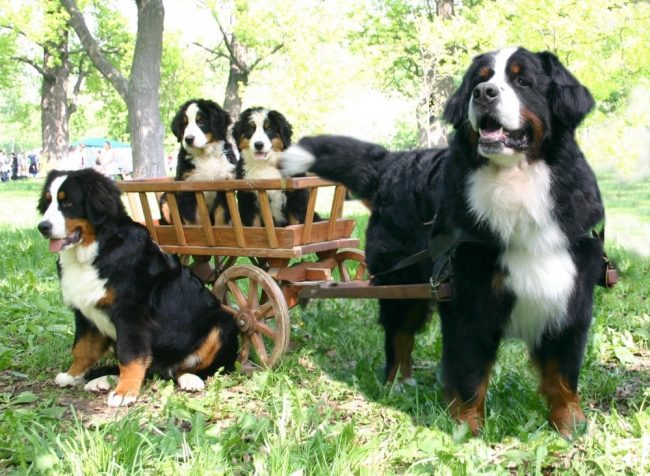
Some owners put their pets in carts for a while to ride children
The breed owes official recognition to the winemaker and owner Hotel F. Schärtenläibu, who lives in Burgdorf.
He really liked the three-color peasant dogs and, traveling around the country, he began to buy the most typical of them representatives.
The first step in legalizing the breed was the participation of six males and one bitch at the show in Bern.
Subsequently, a huge contribution to the standardization of the breed made Professor Heim, who investigated four varieties of mountain dogs Switzerland.
Formation of the modern type, its name and description of the breed belongs to him. Thus, four The main varieties of the breed:
- Bernese Mountain Dog;
- Entlebucher Mountain Dog;
- Appenzeller mountain dog;
- Gross Mountain Dog (Greater Swiss).
1907 was the year the breed was born: the standard was adopted, description of the breed was published and the Durbach Club was founded in 1912 renamed the Bernese Mountain Dog Club.
Adjustments to the standard were made in 1951 and 1973. In 1993 the modern standard was adopted (FCI No. 45).
Six generations represented at the 1947 exhibition in Basel mountain dogs. In the mid-20th century, a breed that loses its characteristic temperament and type, needed an influx of “fresh blood”.
Newfoundland blood originally appeared completely by accident – unplanned mating of a dog Pluto von Erlengut and females of the Bernese Mountain Dog.
The great-grandson of this couple, perfectly painted Alex von Angetdorf became 1956 world champion. It was he who influenced the breed, becoming producer 51 litters.
The 80s of the XX century, the breed reached the peak of popularity almost in all countries of the world. Accordingly, the price of puppies.
Psychology
A dog with a stable psyche, calm and unobtrusive in the house. Pride of representatives of the breed does not allow the Bernese Mountain Dogs asking for master’s affection and attention.
They do not perceive physical punishment at all. To rule the dog can only be with the help of the established authority the owner.
The attitude towards animals and children develops with a hint indulgence. These dogs, like German boxers get along well with other homeworkers animals.
Despite all of the above, a calm burn without the slightest procrastinating capable like a fighting dog, become a fearless and fierce protector, if the owner, his family or property is in danger.
Application
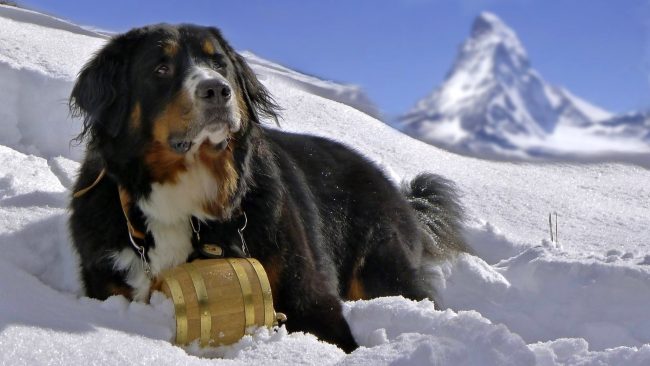
On the account of the Bernese Mountain Dog (pictured), not one saved human life
Despite the initial use of these dogs for grazing herds, guards and work in teams, today it is the first the dog’s turn is a companion.
However, representatives of the breed are widely used in rescue operations in the mountains or in disaster areas. Newfoundland genes seem to be triggering.
Dogs and the police work like hovawarts and groenendals. Great flair makes of them excellent wanted persons. Excellent perceive agility, succeed in guard duty and protective training.
Important! Bernese mountain dog – excellent dog for families with small children. Brave, smart and intelligent friend will gladly substitute his mighty back a child who is just learning to walk.
Due to its versatility, representatives of the breed have become real movie stars, starring in many feature films and commercials.
How to choose a dog
The main criteria for choosing a Bernese puppy mountain dog serve color, structure and character of a small representative of the breed.
The width of the marks should be close to the “golden mean”, however, neither a thin white stripe on the face, nor a large mask, in principle, considered a vice.
This cannot be said for the high-rising white color on the legs or blue eyes. “White socks”, as well as the white tip of the tail desirable but not required.
The breed description allows a small white spot on the back of the head, but it is not desirable Red tan should create a boundary between black and white. The perfect puppy is depicted in the following a photo.

The main criterion for selection should be a general healthy appearance. puppy
Having dealt with the color, we move on to the bite of the puppy. He must to be normal – a snack and, conversely, “overshot” are unacceptable.
You should also pay attention to the filled muzzle, thick legs and a wide back – all this together guarantees you in later a large dog that meets breed standards.
The indicator in this case is the puppy’s ears, than they bigger, the bigger it grows.
Be sure to pay attention to the nature of the small Bern. A timid and cowardly puppy will not change anything. Adult a dog with such traits will be disqualified at the show and will not approved for breeding.
The puppy must behave at ease, he is bold and innocent comes to a stranger, allowing to stroke himself.
Having heard a sharp enough sound, a small barn should not run away cowardly, but rather curiosity and study noisy subject. For this test, a bunch is most often used. keys thrown near the puppy.
Excessive viciousness of the puppy is also unacceptable. Showing aggression already at an early age, the puppy can grow into a vicious uncontrollable a dog.
Watching the puppy, again, the rule should be followed “middle ground” and choose one that shows no excessive cowardice, no aggression.
The puppy’s price directly depends on the destination that you planning for him. Your pet will cost you less future winner of the exhibitions.
Care Features
Given the origin of the breed, dogs are positioned to to please the owner. Because of this, they require a lot attention from the owner. With his lack, Burns can even develop depression.
Oddly enough, these are quite lazy dogs. They are ready to play actively, but not for long. Given this, dogs are excellent suitable for inactive people who prefer a moderate life rhythm.
Following her cattle dog instincts, Bernese Mountain Dogs will constantly monitor the situation, considering themselves responsible for everything that happens.
These features should be considered when caring for your the dog.
Keep an eye on your dog’s nutrition, which is directly related with her well-being and good exterior. The rules must be followed. hygiene, in addition to combing, monitor the cleanliness of the eyes and ears.
How to clean the ears of the dog will tell articlehttps: //kot-pes.com/kak-chistit-ushi-sobake/
Pay attention to the dog’s claws and do not allow them excessive growth. Periodically, you may need to trim them in veterinarian or, having such skills – on their own.

Proper care will ensure your dog a long life.
Combing
Representatives of this breed molt quite strongly. For, so that the wool does not fly all over the house, you need to regularly comb out the dog.
In the summer, it is advisable to carry out the procedure daily. IN the rest of the time when the molt is moderate, you can comb the dog as a host once a week, or even once every two weeks.
It is important to prevent the formation of lumps from tangled wool. Them will have to be cut, but doing this is constantly undesirable.
Important! Given the luxurious thick coat, dogs are subject to overheating. Protect from this your pet.
Walking
Particular attention should be paid to physical activity. IN Unlike his dog breeds, Bern doesn’t need a lot of them. quantity.
You can just walk with your pet for a long time, occasionally making light runs, play with him.
Important! For the Bernese Mountain Dog, the main thing is the company of the owner and his attention. No matter how energetic your walks will be, the main thing is that you are near.
The stick game shown in the photo is one of my favorite this breed
Food
Both a puppy and an adult mountain dog need a full, balanced nutrition. It is feeding that is the key to health and longevity of your pet.
Of particular importance to the breed are vitamins different groups. Based on the foregoing, in the monthly diet baby foods should be present protein foods.
Do not exceed their content in food above the mark of 18 – 26%, since inactive dogs are obese. You can also moderate amounts add dry feed.
Be sure to add cottage cheese, eggs, milk and fish. Porridge should occupy no more than 1/3 of the food received. From five months add vegetables and fruits in food.
About what cereals can be given to dogs, will tell articlehttps: //kot-pes.com/kakie-krupy-mozhno-davat-sobakam/
In order for the food to be the most complete, it should cook the so-called meat mix – mixed scar, diaphragm, kaltyk, heart, udder, liver, chicken paws and stomachs (the latter play an important role in digestion).
As for the diet, you must adhere to such graphic arts:
- 1-2 months – 5-6 times a day
- 2-4 months – 4-5
- 4-6 months – 3-4
- 7-12 months – 2-3
- From 1 year – 2 meals a day
In the early days of your baby’s stay in your home, do not abruptly change his diet, observed by previous owners. This will allow avoid possible indigestion.
Important! Food should be placed on a stand. This way you avoid curving the fragile ridge puppy.
Health
The health of the Bernese Mountain Dog directly depends on his the owner.
Long walks in the fresh air, communication with a pet, good nutrition and lack of stress contribute to excellent Burns’ well-being for years to come.

If the dog behaves unnaturally, it is urgent to withdraw her to the vet. A timely diagnosis increases the chances of recovery.
Characteristic diseases
The main diseases that owners may face Bernese Mountain Dogs are:
- Joint dysplasia – characteristic of all large dogs
- Malignant Hysteocytosis
- Congenital renal disease
- Weeping eczema
- Oncology
- Inversion of the eyelids
Important! Almost all of this can be avoid if you adhere to the proper diet of the dog and give the dog moderate exercise.
Vaccinations

Health and even life depend on timely vaccination. your favorite
The puppy is first vaccinated at the age of 1.5 – 2 months. As a rule, a multivalent drug is used, protects against hepatitis, leptospirosis, parovirus enteritis.
At the age of six months, a comprehensive vaccination and rabies vaccination. Similar procedures are carried out and year-old the dog.
Subsequently, vaccinations must be done annually. Not worth it forget about periodic, usually seasonal, processing of burns from fleas and ticks.
The price of medicines is constantly changing, however vaccination will be able to protect your pets from serious diseases.
Knitting

Choosing a pair for free knitting should be based on sympathy animals to each other. The dogs in the photo are clearly friendly between by myself
The first estrus in representatives of the breed occurs in a one-year-old age. A 6, 7-month cycle is considered normal. The first knitting is recommended with an experienced specialist who will tell you all the subtleties of this matter.
It is best to knit 10 – 13 days from the start estrus. During this period of isolation from the loop of a bitch become light pink and when stroking the back, it deflects tail toward, indicating its readiness for mating.
Important! Both male and bernese female Sennenhund must be knitted before the age of three, as subsequently, a dog that is so inactive in this regard can completely lose interest in mating.
Bernese Mountain Dog: A dog that smiles
Bernese Mountain Dog is a universal companion. Flexible character and luxurious appearance make this breed unique.
Igor Bazhyn6 Overall Summary Feature6Total EditorsAggression2Adaptability8Activity8Weight8 Training6Friendliness10Playability8Intelligence8Noise406Total users: Aggression1 Adaptability8Activity6Weight9 Training8Friendliness10Playfulness8Intelligence8Noise10 Add your review | Read reviews and comments


